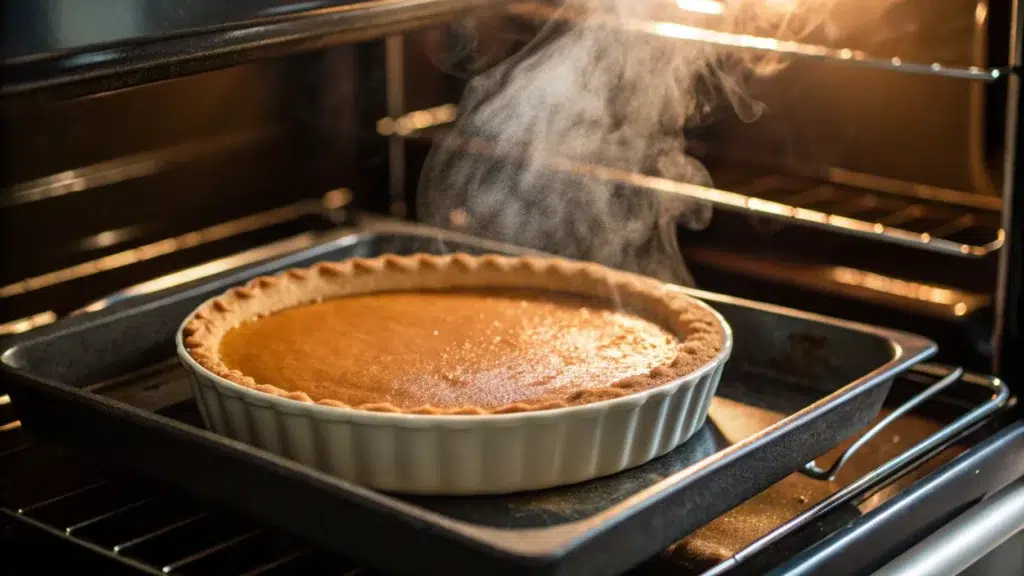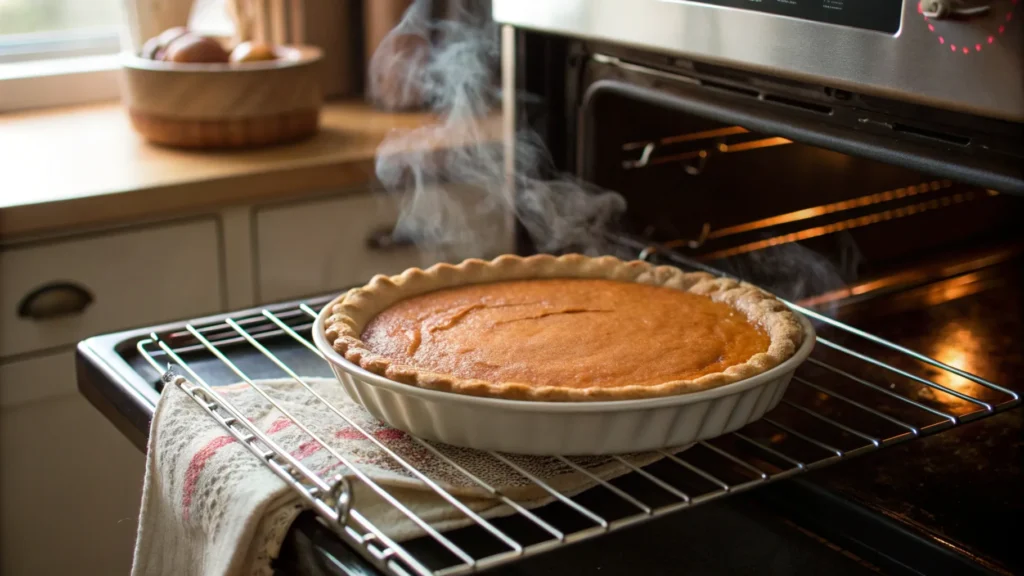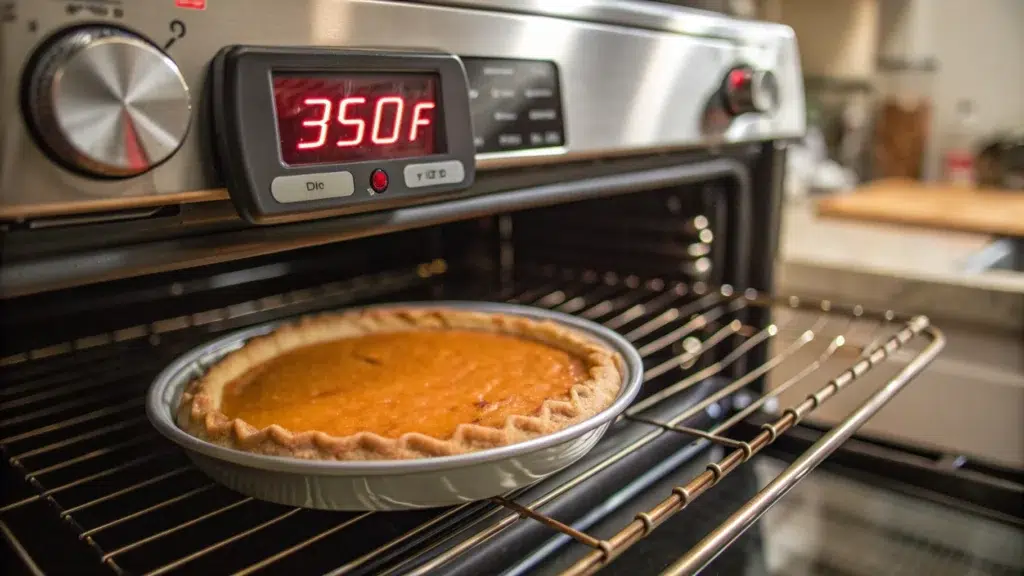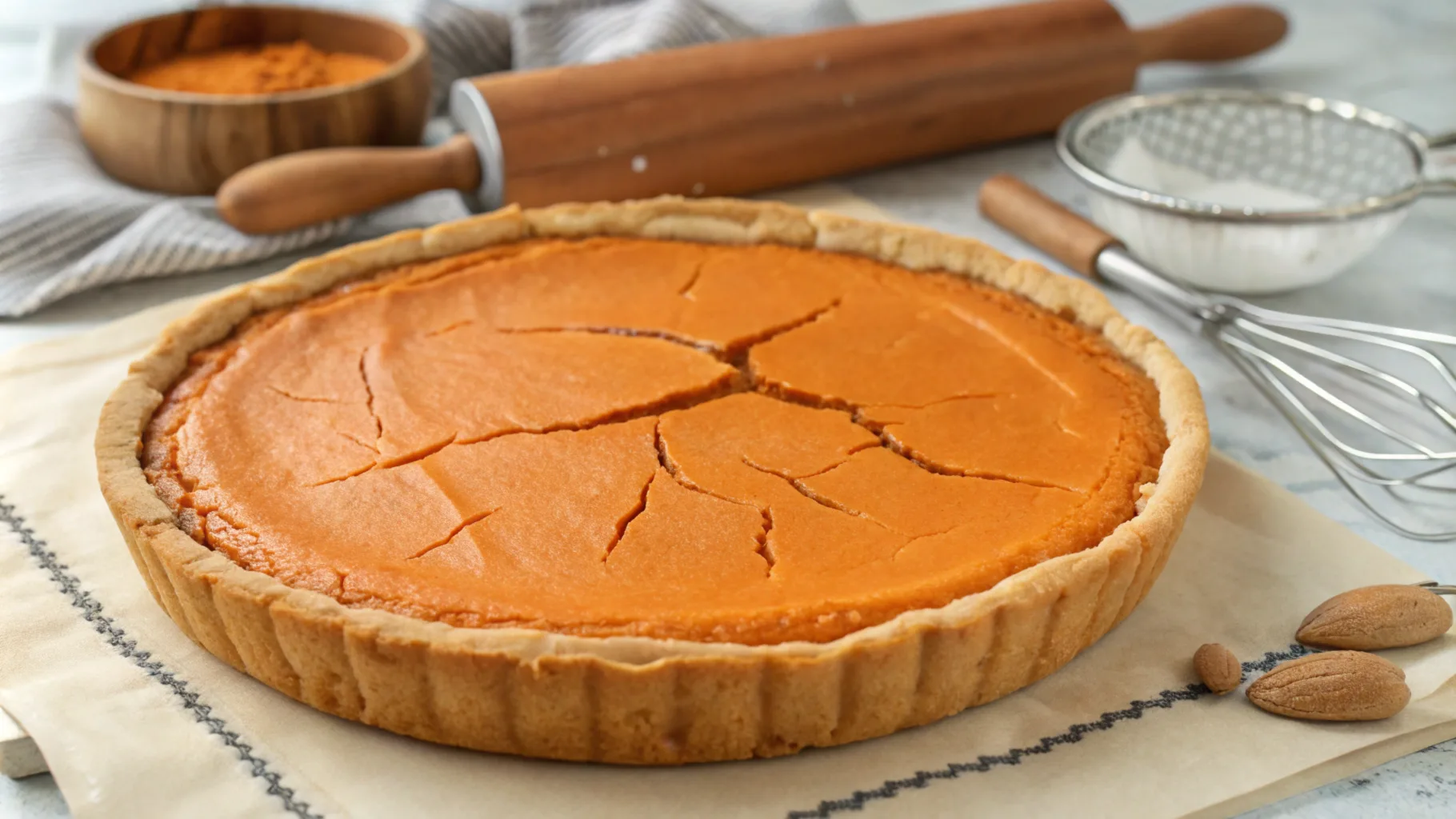Why sweet potato pie cracks is a common frustration for bakers of all skill levels, but understanding why sweet potato pie cracks can help you avoid this issue and create a smooth, flawless dessert. Sweet potato pie, a beloved custard-based treat known for its velvety texture and rich flavor, requires careful attention to ingredients, baking temperatures, and cooling methods. It may seem tricky, but with the right approach, achieving a crack-free pie is absolutely within reach.

What Causes Cracks in Sweet Potato Pie?
Cracks on the pie’s surface, while mostly cosmetic, often signal deeper issues with the pie’s structure. Problems like overbaking, moisture loss, or rapid cooling are the usual culprits. When these factors aren’t properly managed, the custard filling can tighten, dry out, or shrink unevenly as it sets leading to those dreaded cracks.
How This Guide Will Help
Fortunately, understanding the science behind the baking process, paired with a few proven techniques, can make all the difference. In this guide, we’ll examine exactly why sweet potato pie cracks, highlight the common baking mistakes that cause them, and provide easy, step-by-step tips to prevent them.
Perfect Your Sweet Potato Pie
Whether you’re baking for a holiday gathering, a special occasion, or simply fine-tuning your kitchen skills, this guide will help you achieve a pie that looks as smooth and beautiful as it tastes. Let’s get baking!
The Science Behind Why Sweet Potato Pie Cracks
To understand why sweet potato pie cracks, you must first grasp how the custard filling works. Custard pies rely on eggs, starch, and moisture to achieve their smooth, creamy texture. Here’s how these components interact:
1. Egg Proteins
Eggs are the foundation of custard structure. When exposed to heat, the proteins in eggs denature (unfold) and coagulate (form a network). This process thickens the filling and allows it to set. However, when the proteins overheat, they tighten too much, causing the custard to shrink and pull apart resulting in cracks.
- Tip: Monitor baking temperature carefully to avoid overcoagulation.
2. Starch Gelatinization
Sweet potatoes contain natural starches that absorb moisture and swell during baking. This process gives the filling its creamy consistency. However, when too much moisture evaporates, the starch dries out and destabilizes the custard, making it prone to cracking.
- Tip: Retain enough moisture in the filling to prevent it from drying out.
3. Moisture Content
Moisture is essential for smooth custards. Without it, the filling becomes dry and rigid, increasing surface tension and creating cracks during cooling. Properly balanced moisture prevents this issue and results in a soft, creamy texture.
By managing heat, moisture, and the natural behavior of egg proteins and starches, you can keep your custard stable and crack-free.
10 Proven Steps to Prevent Sweet Potato Pie Cracks

1. Use the Right Baking Temperature
Sweet potato pies bake best at a steady 350°F to 375°F. This lower temperature allows the custard filling to set slowly without puffing up or overcooking. Using an oven thermometer can help achieve accuracy.
2. Don’t Overbake
To avoid overbaking, check the pie 10 minutes before the suggested baking time ends. The pie is done when the edges look firm, but the center has a slight jiggle when gently shaken. Overbaking leads to cracks, so don’t wait until the middle is fully set carryover heat will finish it as it cools.
3. Bake in a Water Bath (Optional)
A water bath, also called a bain-marie, helps regulate the baking temperature. Place the pie dish in a larger pan, then pour hot water into the pan until it reaches about halfway up the pie dish. This gentle heat reduces the risk of cracks.
4. Avoid Overmixing the Filling
Mix the filling just until smooth. Overmixing introduces too much air, which causes the pie to rise unevenly in the oven and crack as it settles.
5. Cool the Pie Gradually
Once the pie is baked, turn off the oven, crack the oven door, and let it sit for 10–15 minutes. Gradual cooling helps the filling settle without sudden shrinkage, which causes cracks.
6. Add a Protective Shield to the Crust
Sometimes, the crust can overbake while you’re trying to get the filling just right. Use a pie crust shield or aluminum foil to cover the edges. This protects the crust while letting the filling bake evenly.
7. Test the Pie for Doneness Properly
To make sure you don’t overbake, test the pie by inserting a knife or toothpick about 1 inch from the center. If it comes out mostly clean, the pie is done. The center will continue to firm up as the pie cools.
8. Use Room Temperature Ingredients
Cold eggs, milk, or mashed sweet potatoes can cause uneven baking. Let all your ingredients come to room temperature before mixing. This guarantees a smooth, consistent filling that bakes evenly.
9. Avoid Opening the Oven Too Often
Every time you open the oven, the temperature drops. These fluctuations can interfere with the pie’s smooth setting process and lead to cracks. Only open the oven when necessary to check doneness.
10. Chill Before Slicing
Allow the pie to cool completely at room temperature, then refrigerate for at least 2–3 hours before slicing. This helps the filling set fully and prevents it from breaking apart when cut.
Final Thoughts
By taking these steps, your sweet potato pie will not only taste amazing but will look flawless, free from cracks or uneven textures!

Sweet Potato Pie Perfection: Final Recap
To bake a crack-free, perfectly smooth sweet potato pie:
- Bake at the Right Temperature: Stick to a steady 350°F to avoid overbaking.
- Watch the Bake Time: Remove the pie when the edges are set, and the center has a slight wobble.
- Avoid Overmixing: Keep the filling smooth without adding too much air.
- Cool Gradually: Let the pie cool in the oven for a few minutes, then slowly transition it to room temperature.
- Shield the Crust: Protect the edges with foil or a crust shield to prevent burning.
If cracks happen, don’t stress dress it up with whipped cream, pecans, or a dusting of powdered sugar. With these techniques, you’ll create a silky, flavorful pie that’s as beautiful as it is delicious. Sweet potato pie success is all about patience and a little baking know-how!

Common Reasons Sweet Potato Pie Cracks
Overbaking and Protein Tightening
Overbaking is the most frequent cause of cracks in sweet potato pies. When the filling is exposed to excessive heat:
- Egg proteins tighten and shrink, causing the filling to pull apart and crack.
- Even after removing the pie from the oven, residual heat can continue cooking the custard past its ideal point.
How to Prevent Overbaking:
- Use a digital thermometer to monitor the pie’s internal temperature, which should range between 160°F and 170°F.
- Remove the pie when the center is just set but slightly jiggly.
- Begin checking for doneness 10 minutes before the recipe’s baking time ends.
How to Avoid Overbaking Sweet Potato Pie
Rapid cooling can cause significant structural stress on the custard. Here’s why:
- The surface cools and contracts faster than the interior.
- This uneven contraction creates tension in the custard, resulting in cracks.
How to Cool a Pie Gradually:
- Turn off the oven and crack the door open for 15-20 minutes before removing the pie.
- Transfer the pie to a wire rack to cool at room temperature.
- Avoid placing a hot pie directly into the fridge, as the abrupt temperature change can worsen cracks.
Allowing the pie to cool gradually helps maintain its structural integrity and minimizes stress on the filling.
Tips for Cooling Sweet Potato Pie Without Cracks
Oven temperature inconsistencies are a hidden culprit behind pie cracks. Uneven or excessive heat can bake the custard unevenly, causing specific areas to overcook and contract.
Solutions to Oven Inconsistencies:
- Use an oven thermometer to confirm your oven is calibrated correctly.
- Bake at a gentle temperature of 325°F to 350°F for even cooking.
- Rotate the pie halfway through baking to guarantee even heat exposure.
Ingredient Imbalances
The ratio of eggs, sweet potatoes, and liquids plays a critical role in preventing cracks. Too many eggs or insufficient moisture can destabilize the filling.
- Too Many Eggs: Excessive protein causes the custard to set too firmly, increasing its tendency to crack.
- Low Moisture: A lack of liquid makes the filling dry and prone to contraction.
How to Balance Ingredients:
- Use 2-3 large eggs for a standard 9-inch pie.
- Include enough milk or cream to maintain a soft, creamy filling.
- Follow a tested recipe and measure ingredients accurately.
Proven Techniques for a Crack-Free Sweet Potato Pie
To achievea flawless sweet potato pie, implement these techniques:
- Bake at the Right Temperature: Use a low and steady temperature (325°F to 350°F).
- Monitor Doneness: Remove the pie when its internal temperature reaches 160°F to 170°F.
- Cool Gradually: Let the pie cool in the oven first before transitioning to room temperature.
- Avoid Overmixing: Gently mix the filling to prevent incorporating air bubbles.
- Balance Ingredients: Follow a trusted recipe to achieve proper egg-to-liquid ratios
These steps guarantee even cooking, moisture retention, and structural stability for a crack-free finish.
The Best Sweet Potato Pie Recipe
This recipe combines a smooth, creamy filling with just the right balance of spices for a classic, crack-free sweet potato pie.
Ingredients
For the Pie Filling:
2 cups mashed sweet potatoes (about 2–3 medium sweet potatoes, cooked and peeled)
3 large eggs, room temperature
1 cup evaporated milk (or heavy cream)
3/4 cup granulated sugar
1/4 cup packed brown sugar
1/2 teaspoon salt
1 teaspoon vanilla extract
1 teaspoon ground cinnamon
1/2 teaspoon ground nutmeg
1/4 teaspoon ground ginger (optional)
2 tablespoons melted unsalted butter, cooled
For the Pie Crust:
1 unbaked 9-inch pie crust (store-bought or homemade)
Directions
- Prepare the Sweet Potatoes
Preheat the oven to 375°F (190°C).
Peel and cut sweet potatoes into chunks. Boil them in a large pot of water until fork-tender (about 15–20 minutes), or roast them whole in the oven until soft.
Mash the cooked sweet potatoes until smooth. Allow them to cool slightly.
- Make the Pie Filling
In a large mixing bowl, combine the mashed sweet potatoes, eggs, evaporated milk, granulated sugar, brown sugar, salt, vanilla extract, cinnamon, nutmeg, and ginger (if using).
Stir in the melted butter and mix until smooth. Avoid overmixing to prevent air bubbles.
- Assemble the Pie
Place the unbaked pie crust in a 9-inch pie pan and crimp the edges as desired.
Pour the sweet potato filling into the crust, spreading it evenly with a spatula.
- Bake the Pie
Place the pie on the center rack of the preheated oven. Bake for 45–50 minutes, or until the edges are set and the center has a slight jiggle when gently shaken.
If the crust starts browning too quickly, cover the edges with aluminum foil or a pie crust shield.
- Cool and Chill
Turn off the oven and let the pie cool with the oven door cracked open for 10–15 minutes. Then remove it from the oven and place it on a wire rack to cool completely.
Once cooled, refrigerate the pie for at least 2–3 hours to allow the filling to fully set.
Serving Suggestions
Serve your sweet potato pie chilled or at room temperature.
Top with whipped cream, a sprinkle of cinnamon, or toasted pecans for a festive touch.
Enjoy this classic southern sweet potato pie as the star dessert for holidays, family gatherings, or any special occasion!

Crack-Free Sweet Potato Pie Recipe
Ingredients
Equipment
Method
- Preheat oven to 375°F (190°C). Peel and chop sweet potatoes, boil until tender (15–20 min), or roast whole. Mash until smooth and allow to cool slightly.
- In a large bowl, combine mashed sweet potatoes, eggs, evaporated milk, sugars, salt, vanilla, cinnamon, nutmeg, and ginger. Stir in melted butter. Mix until smooth but avoid overmixing.
- Place the unbaked pie crust in a 9-inch pan and crimp edges. Pour filling into crust and smooth top with a spatula.
- Bake for 45–50 minutes or until edges are set and center jiggles slightly. Cover crust edges with foil if browning too quickly.
- Turn off oven, crack door, and let pie cool inside for 10–15 minutes. Then transfer to wire rack to cool completely. Refrigerate 2–3 hours before slicing.
Nutrition
Notes
Tried this recipe?
Let us know how it was!Conclusion
Cracks in sweet potato pie are a common baking challenge, but they’re completely avoidable with the right knowledge and techniques. By understanding the science behind custard fillings, monitoring temperatures, and cooling the pie gradually, you can achieve a beautiful, crack-free dessert every time. Whether you’re baking for the holidays, a special occasion, or just because, these methods will help you create a smooth and delicious sweet potato pie that impresses everyone.
LET’S STAY CONNECTED! FOLLOW ME ON:
Tried this recipe? I’d be thrilled to see your take on it! Snap a pic and tag me @Sweftyrecipes so I can share your delicious creations with our foodie community.
→ FACEBOOK | INSTAGRAM | PINTEREST
FAQs
1. How do I know when sweet potato pie is done?
Check the internal temperature with a thermometer. It should read 160°F to 170°F.
2. How can I fix a cracked sweet potato pie?
Cover the cracks with whipped cream, a dusting of powdered sugar, or a decorative topping.
3. Why does my pie crack as it cools?
Rapid cooling causes uneven contraction. Cool the pie slowly in the oven before moving it to room temperature.
4. Should I use a water bath for sweet potato pie?
Yes, a water bath can provide gentle, even heat and help prevent cracks.
5. Can I overmix the pie filling?
Yes. Overmixing introduces air bubbles that can destabilize the filling and lead to cracks.

1 thought on “What Causes Sweet Potato Pie to Crack?”
Comments are closed.